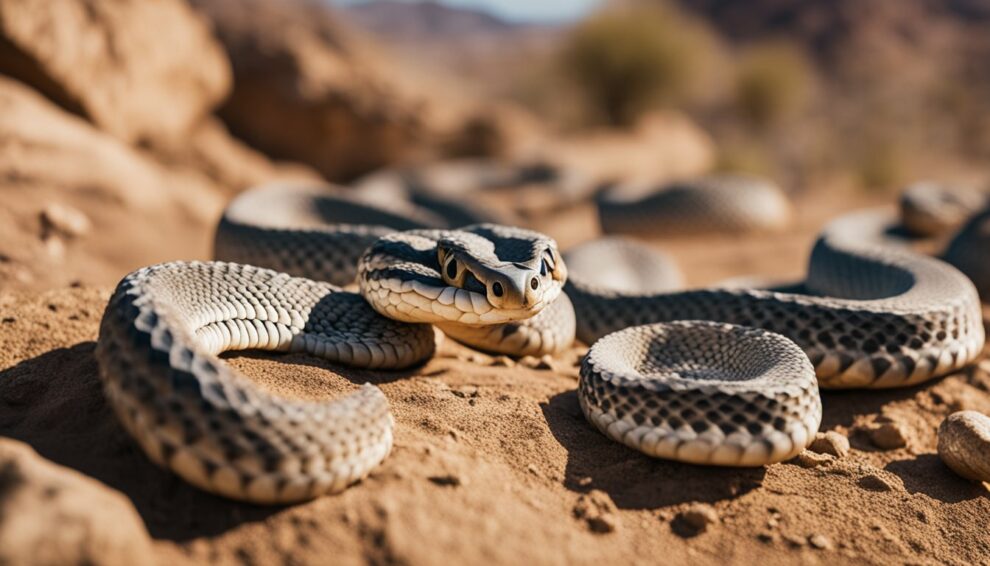Vipers are known for their amazing hunting skills, and one of their most impressive talents is their ability to strike with incredible precision.
These serpents have honed their techniques over millions of years, leading to their reputation as one of nature’s most efficient predators.
When a viper zeroes in on its prey, it uses a combination of sharp vision and sensitive heat-detecting pits to lock onto its target with astonishing accuracy.

Imagine being able to detect the slightest movement or the faintest body heat of a potential snack.
That’s precisely what vipers do.
They can sense the body heat of small animals, like rodents, which helps them to track their prey even in complete darkness.
Once they have their sights set, vipers can launch a lightning-fast strike, injecting venom into their hapless prey in less than a blink of an eye.
Have you ever wondered what it’s like to move with the speed and grace of a viper?
These snakes can control the flow of their venom, deciding how much to use based on the size and type of their prey.
This is not just a spectacular display of nature’s ingenuity; it’s also a critical survival skill.
With each successful hunt, vipers showcase their role as integral parts of their ecosystems, keeping prey populations in check.
Anatomy of a Viper’s Strike

When you watch a viper strike, you’re witnessing a highly specialized and efficient system in action.
Each aspect of their anatomy works together for a successful hunt.
Venom Delivery Systems
At the heart of a viper’s strike lies its venom delivery system, a sophisticated combination of glands and fangs.
Vipers possess hinged fangs that stay folded back in the mouth when not in use and then spring forward to inject venom as they strike.
These fangs, with channels as fine as hypodermic needles, carry venom from the gland where it’s stored, directly into their target.
Did you know that the amount of venom a viper can inject can be controlled?
Yes, these snakes can decide how much venom to use based on the size of their prey!
Muscular Mechanics
The viper’s muscular system is like a coiled spring waiting to release.
Fast-twitch muscle fibers in their bodies contract with incredible speed, catapulting the viper toward its prey in less than a blink of an eye.
What’s truly interesting is how they use their muscles to not only leap forward but to also retract within moments, ready for another strike if necessary.
Sensory Guidance
Can you imagine sensing heat in pitch darkness? That’s what a viper’s heat-sensing pit organs do.
These organs are located between the eyes and nostrils and are incredibly sensitive to the body heat of their prey.
In conjunction with the Jacobson’s organ, which analyzes airborne chemicals, a viper has an almost unmatched ability to detect and track its targets.
This combination of thermal and chemical sensing ensures that even in total darkness, a viper’s strike is unerringly accurate.
The Hunting Strategies

Vipers, with their acute senses and stealth, excel in capturing prey.
Understanding how they hunt can be quite a thrill, especially when focusing on their precision strike techniques.
Camouflage and Ambush
When a viper hunts, it’s all about blending in.
They have this incredible ability to become nearly invisible in their surroundings—it’s like they put on an invisible cloak!
These snakes can stay motionless for a long time, waiting patiently for the perfect moment.
Imagine playing hide-and-seek with someone who’s really good at staying hidden; that’s kind of what a viper does.
When their target finally appears, unaware of the lurking danger, the viper makes its move with lightning speed, launching a surprise attack.
It’s nature’s own drama unfolding right there.
Strategic Biting Points
Have you ever wondered how vipers know just where to bite? Their choice is not random at all.
They aim for specific areas on their prey’s body to immobilize them quickly, usually targeting the head or neck.
It’s like a master archer choosing the bullseye every single time.
This precise targeting allows the venom to work as fast as possible, which is pretty important in the wild where every second counts.
After all, you wouldn’t want your dinner running off while you’re trying to eat, right?
This technique minimizes the struggle, making hunting efficient for the viper and less stressful for its prey.
Adaptations for Precision

Vipers have honed their hunting skills through some remarkable adaptations.
Specifically, their fang structure and neurotoxin concoctions have evolved to enhance their strike precision. Let’s explore these unique traits.
Evolution of Fang Structure
Vipers are equipped with specialized fangs that give them an exceptional advantage during a strike.
These elongated teeth are hinged, allowing them to fold back when not in use and then rapidly spring forward during an attack.
The fang length and shape vary among species, optimized to their prey and environment.
For instance, the Gaboon viper sports the longest fangs of all snakes, reaching up to 2 inches, which is almost as long as the height of a credit card!
The interior of these fangs is worth noting—a hollow channel runs the length, creating an efficient delivery system for venom injection.
It’s like having built-in syringes at the ready, ensuring that their strike is not only precise but also debilitating.
Neurotoxin Variations
Have you ever wondered what gives viper venom its punch? Each species of viper has developed a unique blend of neurotoxins over time.
These neurotoxins target the nervous systems of their prey with stunning specificity.
One compelling example is the rattlesnake, which can control the amount and composition of venom injected depending on the situation—a small dose for a minor threat or a lethal cocktail for a hunt.
The composition of these venoms is a complex cocktail made to match the vipers’ prey.
For smaller rodents, a fast-acting venom ensures quick incapacitation, whereas larger threats may be met with venom that spreads more slowly, buying the viper time to retreat.
Imagine having a tailored medicine cabinet, with a concoction ready for every type of unwelcome guest.
This level of control and diversity in neurotoxins makes vipers’ strikes remarkably efficient.
Frequently Asked Questions

Have you ever wondered how vipers, these stealthy hunters, carry out their precision strikes?
Uncover the secrets behind their successful hunting tactics in the questions below.
How do vipers locate their prey before striking?
Vipers use a combination of sensory data to pinpoint the location of their prey.
They have heat-sensing pits between their eyes and nostrils that detect the infrared radiation emitted by warm-blooded animals.
This allows them to accurately target their prey, even in complete darkness.
What role does a viper’s vision play in its hunting technique?
While a viper’s vision isn’t as sharp as that of some other predators, it is particularly adept at detecting movement.
Their eyes can pick up even the slightest twitches, which is crucial when deciding the precise moment to launch their attack.
Can you describe how vipers measure the perfect striking distance?
A viper’s ability to judge the striking distance is innate.
They often approach their target slowly, and then once within range, they execute a rapid strike.
Vipers are known to control the force of their strike depending on the distance, ensuring that they always hit their mark.
In what ways do vipers adjust their strike based on the size and speed of their prey?
When faced with larger or faster prey, vipers have been known to adjust their striking speed and venom delivery.
They can strike quickly and retreat to avoid counterattacks, or deliver just enough venom to subdue their prey without wasting their precious resource.
What unique features do vipers have that aid in precision when striking?
Vipers are equipped with long, hinged fangs that they can fold back when not in use.
During a strike, these fangs act like hypodermic needles, delivering venom deeply into their prey.
The muscles surrounding their venom glands are also incredibly strong, allowing for precise control over the amount of venom injected.
How does a viper’s strike differ between daytime and nighttime?
Daytime strikes may rely more on visual cues, while nighttime hunting exploits their keen thermal sensing abilities.
Regardless of the time of day, vipers are remarkably accurate, adjusting their technique to ensure they rarely miss their intended target.









